Virtual Field Trip
from virtual-geology.info

Locality 2.2 - Freshwater West
It is important that you access
this field trip on a laptop or desktop PC. Click on any image to enlarge
it.
Explore the area in Google
Maps and Streetview.
Handout: refer to the handout
for today, which contains essential diagrams and information. Don't forget to
use the information in the Field Guide too. Both are available in Course Resources.
Tasks: See today's handout.

Modern Sediments
Before we hit the rocks, this is
another great place to study modern sedimentary processes. We'll spend a little
time looking at the shallow streams running across the beach.
- Watch this
movie [3 minutes] of a fast-flowing freshwater stream across
the beach.
Here are some short movies of sediment
transport made by University of Derby students:

The Milford Haven Group (Lower Old
Red Sandstone)
This is one of the classic sections
in the Old Red Sandstone of South Wales. There is a continuously exposed section
of steeply dipping strata over a distance of nearly 1km. There's a lot to see
and do at this location, and we usually spend most of the day here.
New rock types
At this location, we encounter some
rather strange-looking rocks, with highly irregular white or yellow material,
usually surrounded by a red siltstone or very fine to fine sandstone matrix.
Let's take a closer look.
|
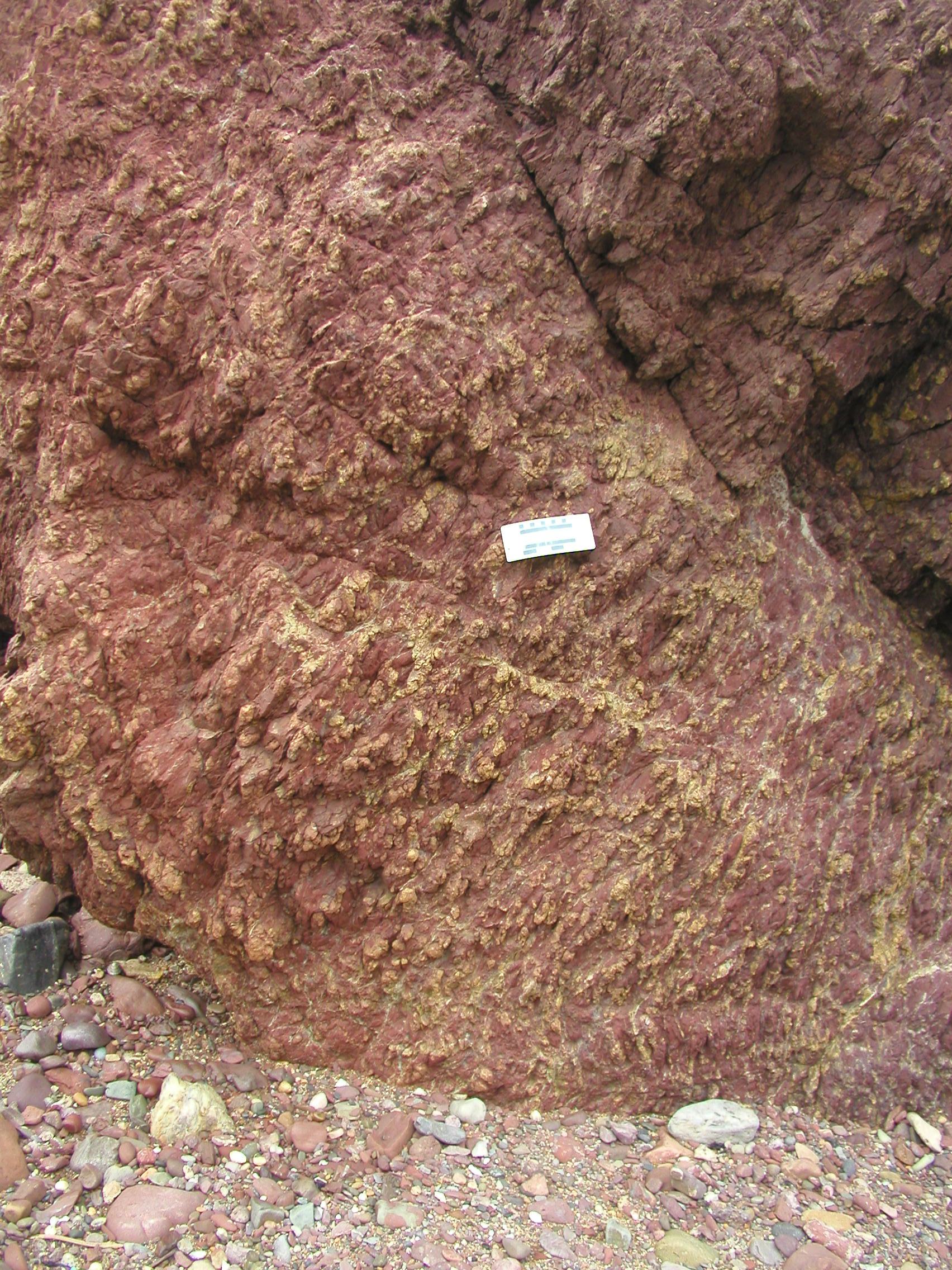
E. The strata dip steeply south (right); they young to the right. There
is a strong cleavage dipping steeply left. Scale is graduated in cm on
its top edge. The irregular light yellow material within the red siltstone
reacts strongly with dilute HCl.
Can you observe any
pattern to the distribution of the yellow material in relation to the
bedding?
|
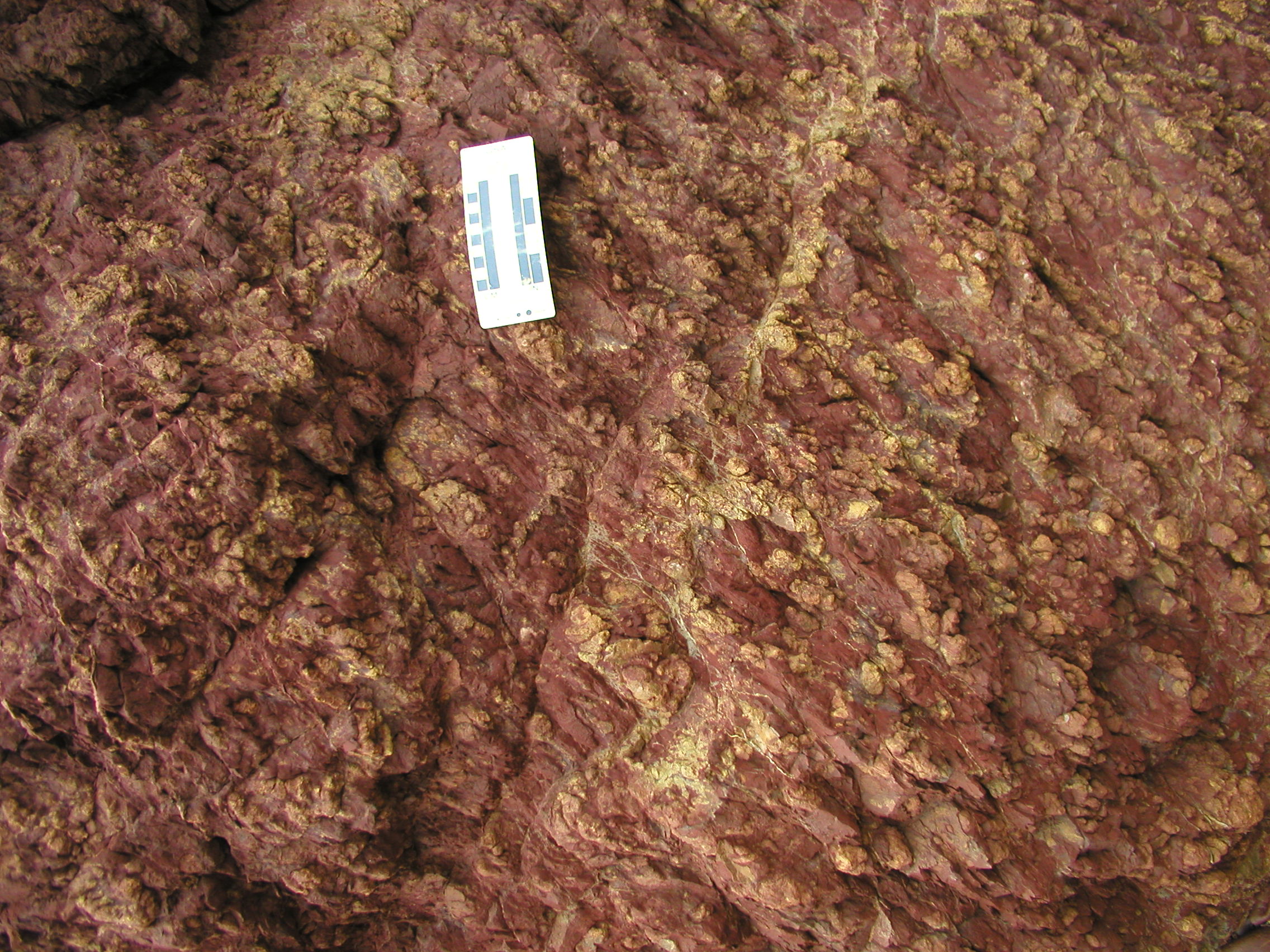
F. Close-up of part of photo E.
Describe the morphology
of the yellow material. What is the relationship between the red siltstone
and the yellow material - could the latter be transported fragments? If
not, how could this material have been emplaced in the siltstone?
|
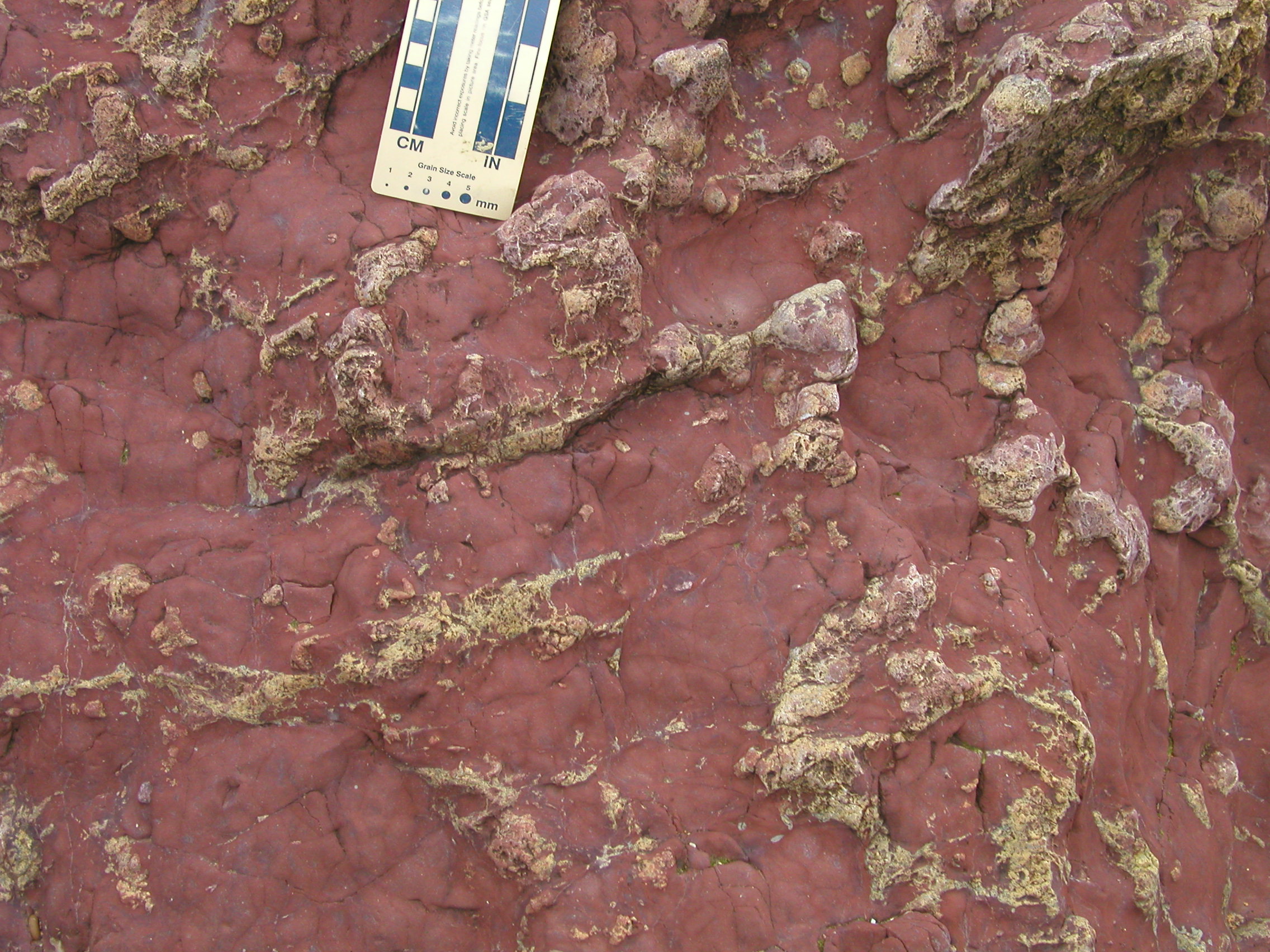
G. In another bed, there is much less of the yellow-white material. In
this facies, throughout this section, the proportion of siltstone to carbonate
varies.
Describe the form
of the carbonate in this image.
|
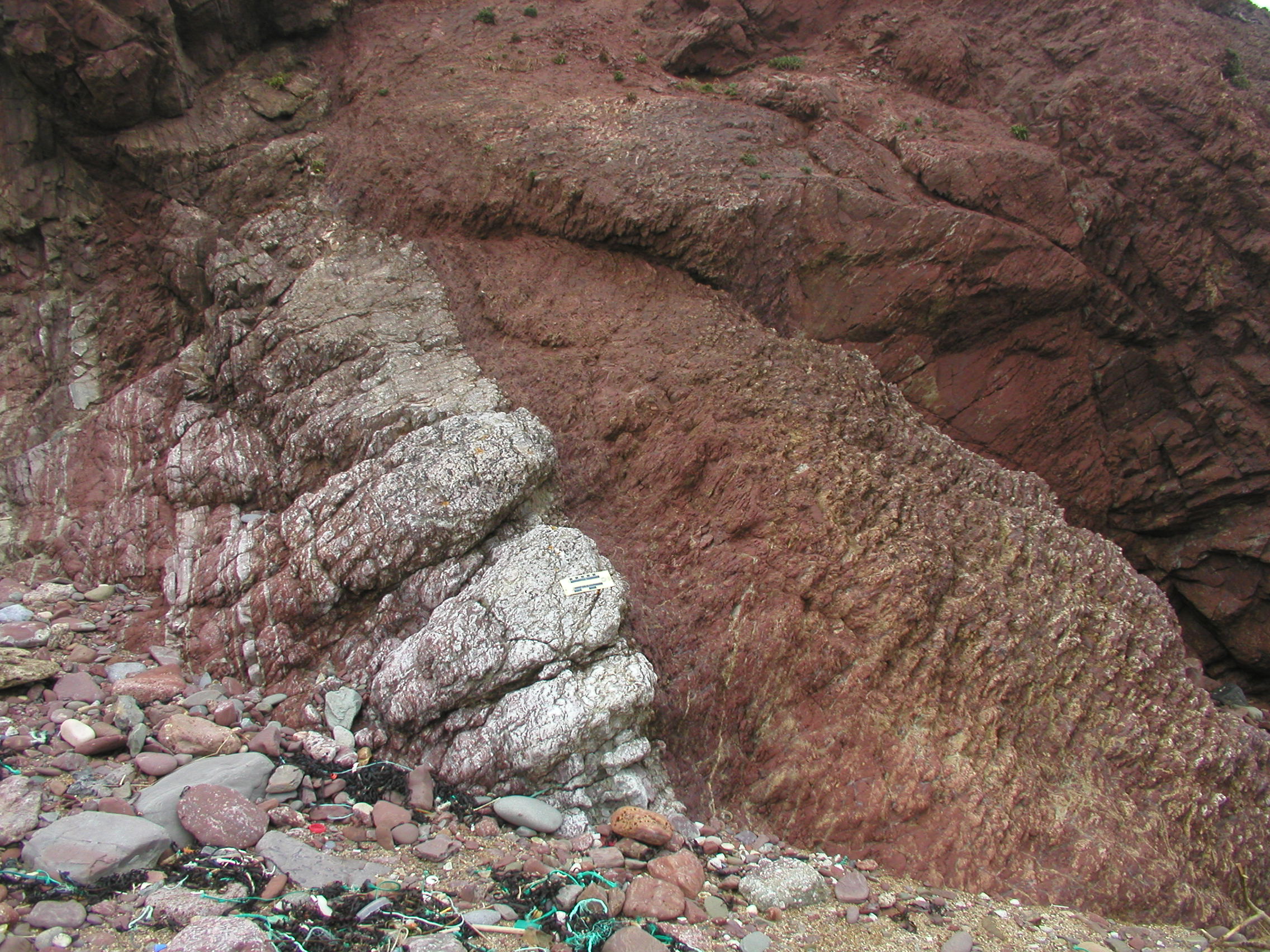
H. These rocks dip and young to the right. The white unit with the scale
near its top is at least 90% calcium carbonate.
How does carbonate
content change upwards through the white unit? What can you deduce about
changing carbonate content in the red siltstone bed above.
|
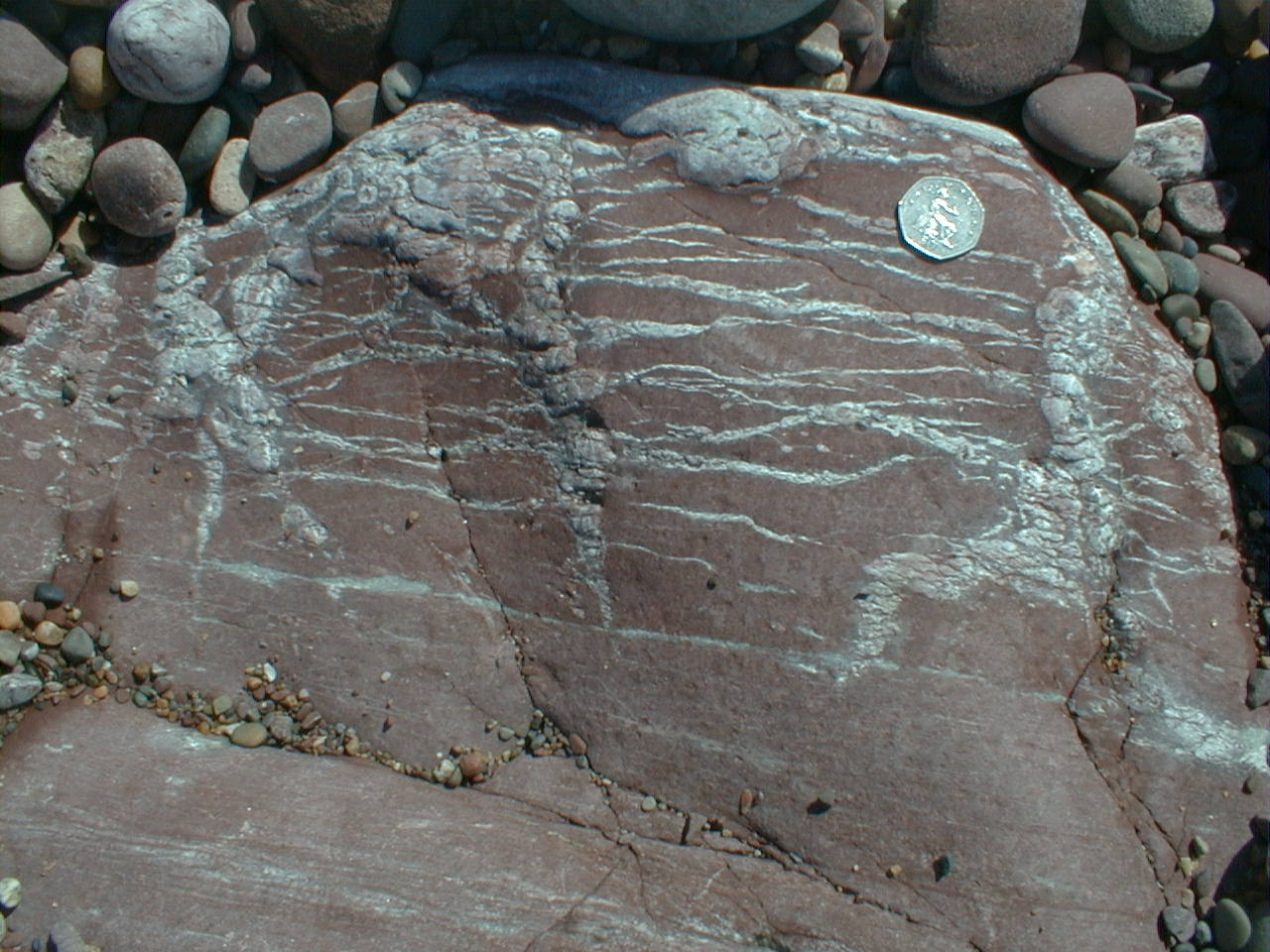
I. In this red siltstone, some of the carbonate is developed parallel
to bedding (left to right). Other carbonate bodies cut across the bedding
in an oblique or perpendicular relationship.
What could these
represent? What has happened later to these vertical carbonate bodies?
(This is a structural geology question!).
|
|
The features of these rocks, with
strong colour mottling and highly irregular distribution of calcium carbonate
sheets, filaments and irregular nodules, are characteristic of a particular
type of palaeosol know as calcretes. What is a palaeosol?
What is a calcrete? Check the reference section in the Field Guide, and
the module text books. Under what conditions do calcretes (also known as caliches)
form - where in the world would you find modern ones? What does this tell us
about the likely climate at the time these rocks were deposited?
For more information, see the article
by Tucker
and Wright (1991).
Logging a section
Here are some short movies made by
University of Derby students logging sections in the Milford Haven Group. They
are useful as an introduction to some of the main rock types and structures.
- Logging
1 [note - primary current lineation is not, as stated, visible in the
section shown, but it may be present on bedding surfaces]
- Logging
2
- Logging
3
Log description: a geologist
has partly logged the section for you. The section is described from the base
upwards. The photographs and text below provide information for you to record
in your notebook, and then transfer to your log. Try to interpret each unit
as you log it. See today's handout and the logging instructions in the reference
section of the Field Guide. Where information is missing from the log description,
you should be able to obtain it from the photos.
The strata dip steeply to the south.
Some photographs show the true dip; others are taken parallel to bedding, so
that sedimentary features are more obvious. Pay particular attention to field
relationships - contacts between units, how units change as you trace them laterally,
etc.
| Bed number |
Base of bed |
Thickness (cm) |
Photo |
Description |
| 1 |
not seen |
25 (minimum) |
|
Red-brown
siltstone with green, irregular reduction spots and irregular carbonate
nodules up to 5cm diameter. |
| 2 |
|
110 |
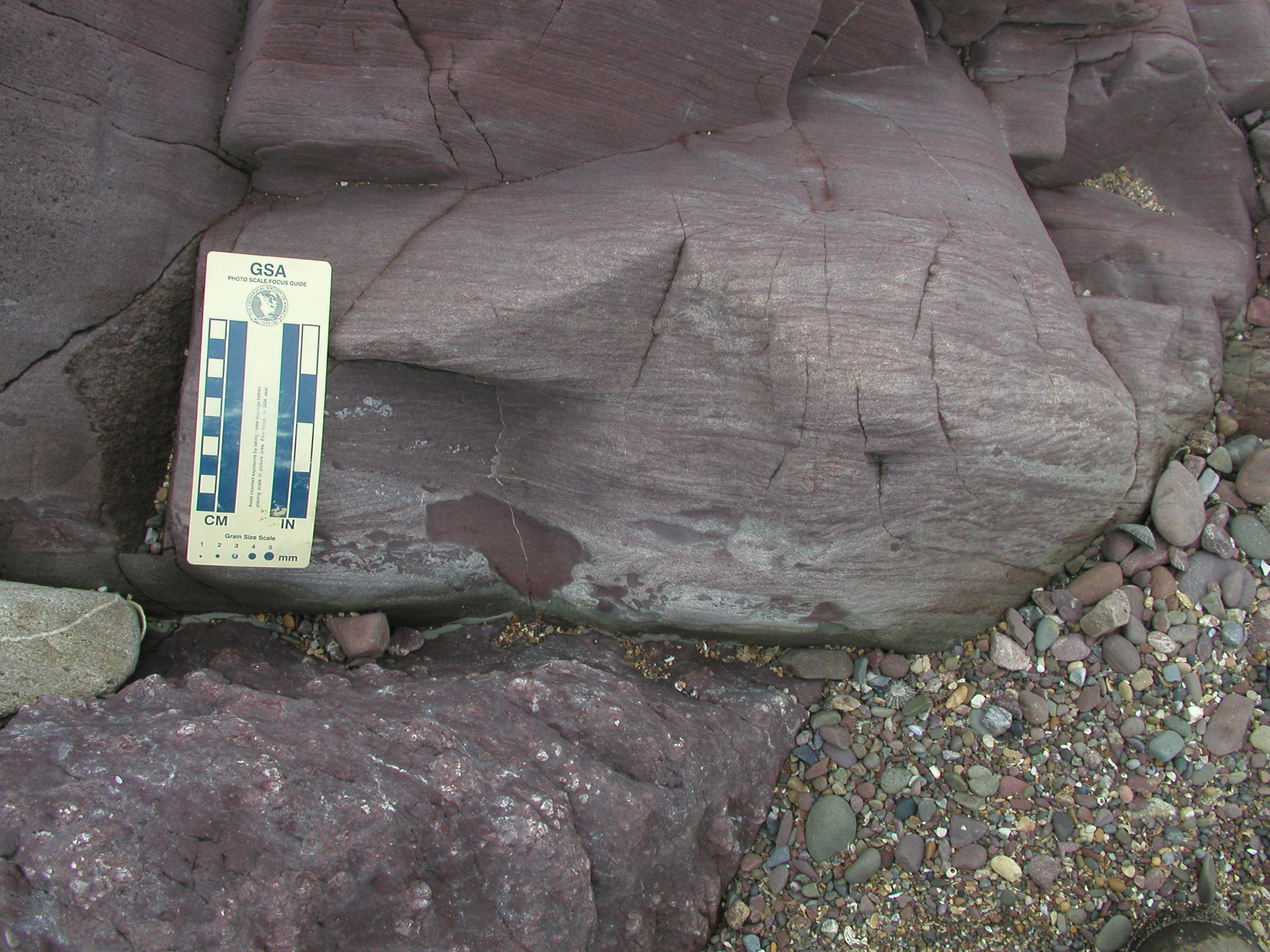
J
|
Photo shows top
of bed 1 & basal contact (just below scale) and lower part of bed
2.
Note the variations
in lithology and sedimentary structures. Similar lithologies and structures
continue to the top of Unit 2.
|
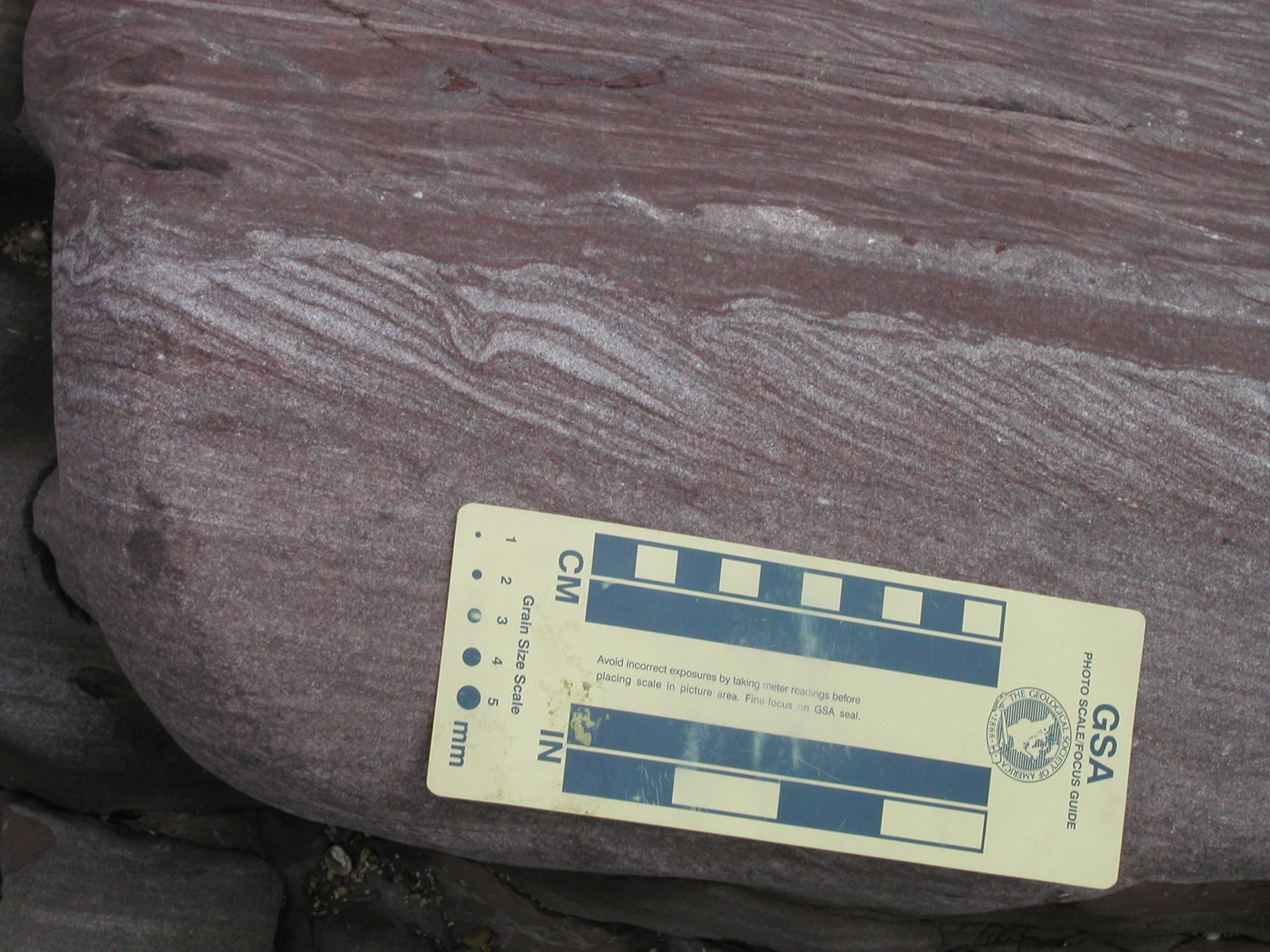
K |
10m along strike
from photo J, and at a height of 20 - 43 cm above the base of Unit 2.
Describe the grain
size and sedimentary structures in the lower and upper parts of the photo.
|
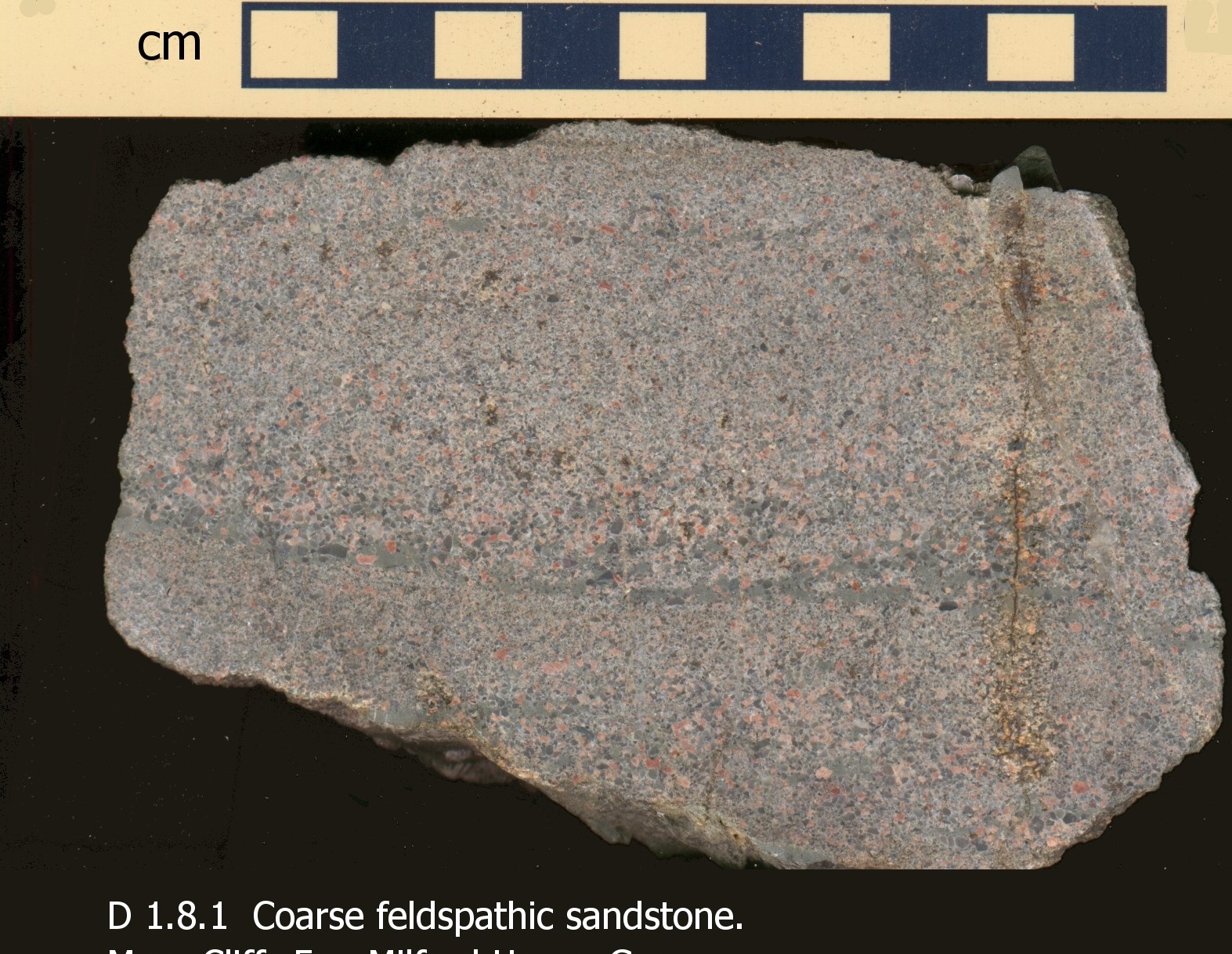
L
|
Hand specimen
photo of the sandstone near the base of Unit 2. |
| 3 |
gradational |
83 |
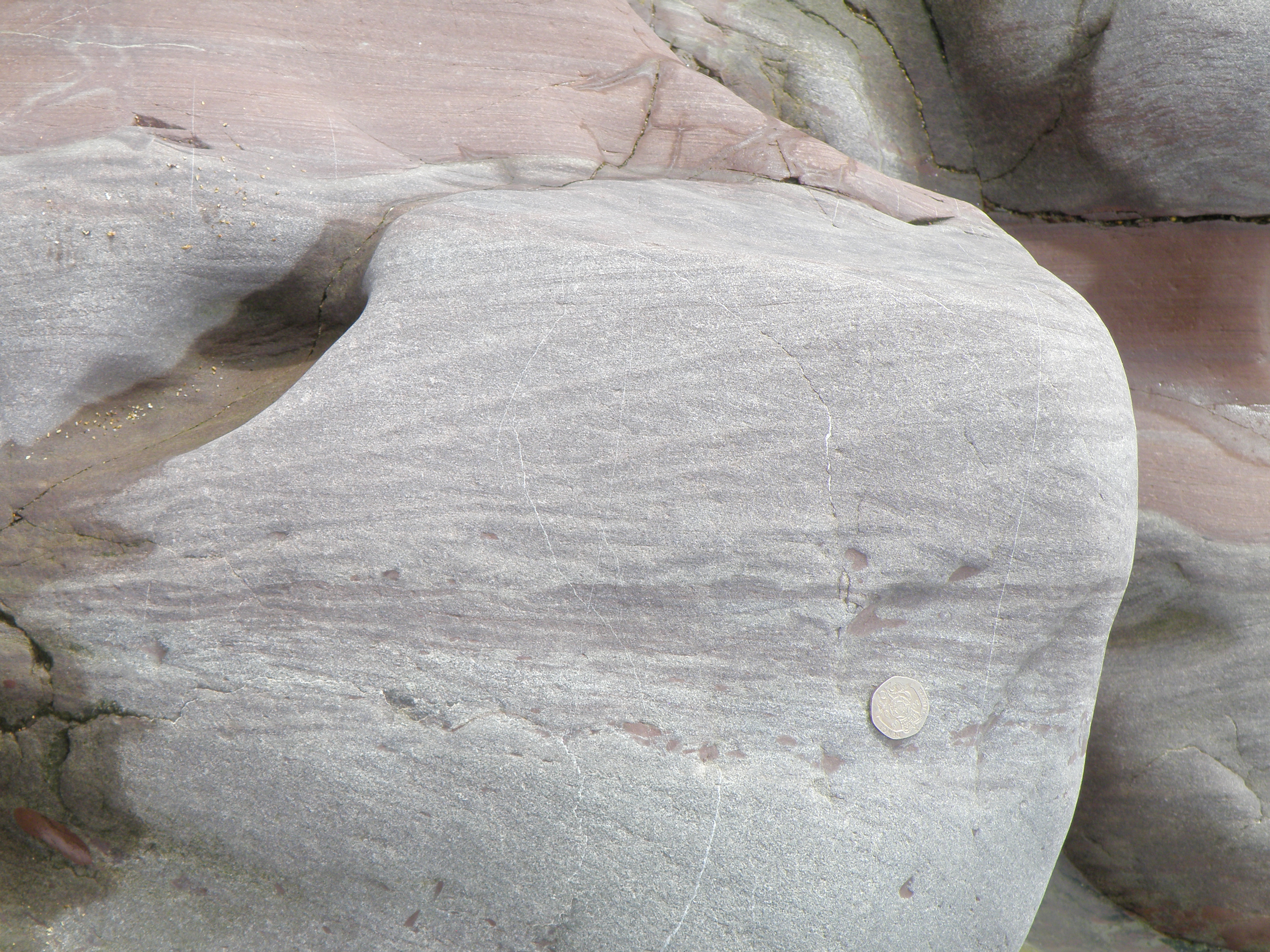
M |
20p coin
for scale. Shows Unit 3 from ca, 40 to 65 cm above its base. Look closely
at the sedimentary structures. |
| 4 |
gradational |
171 |
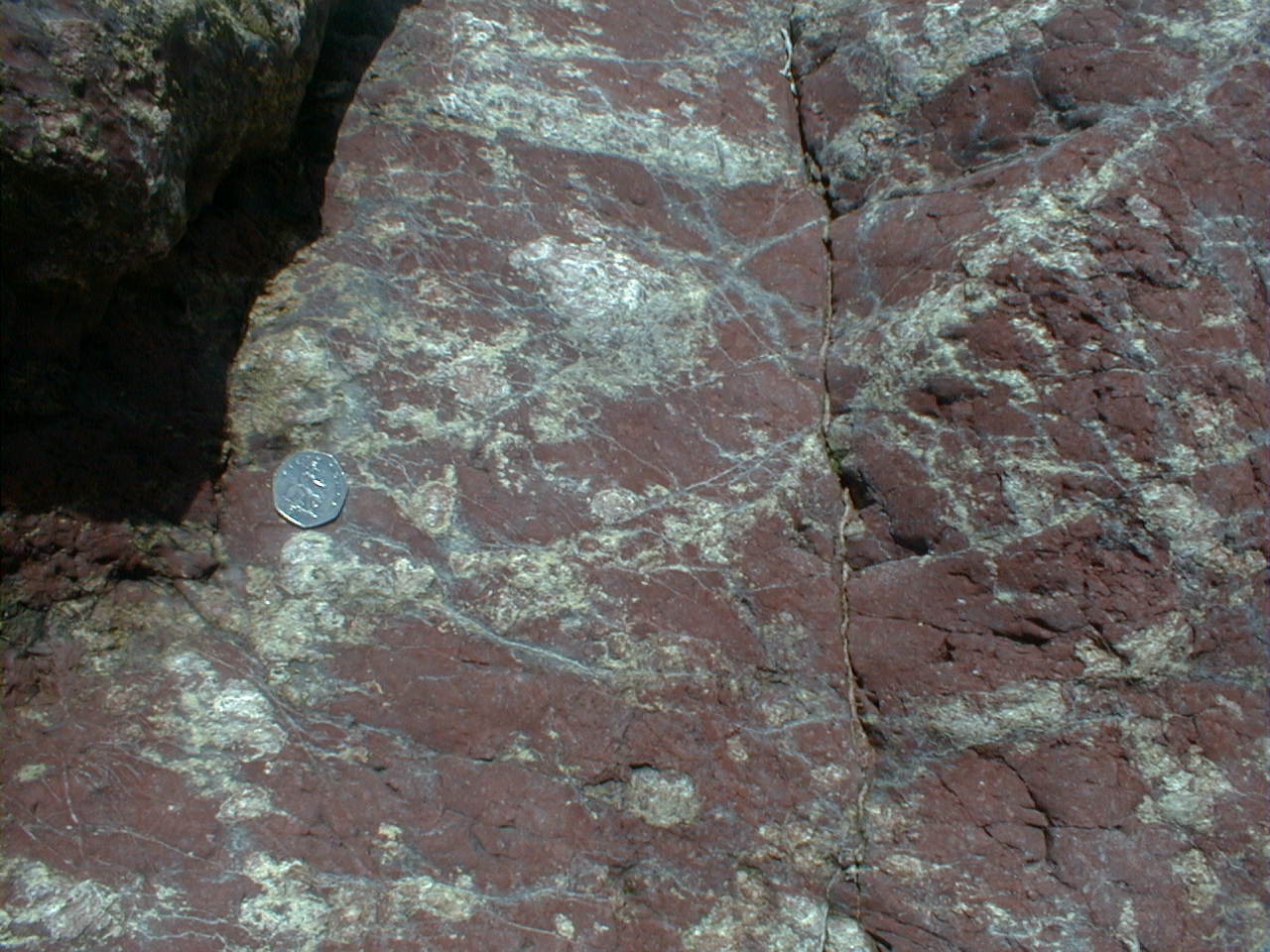
N |
50p coin
for scale. Most of this unit consists of structureless red very fine sandstone
to siltstone, showing a strong tectonic cleavage. In the top 40cm, the unit
contains the features shown in the photo. The yellow-white areas react strongly
with dilute HCl. |
| 5 |
|
68 |
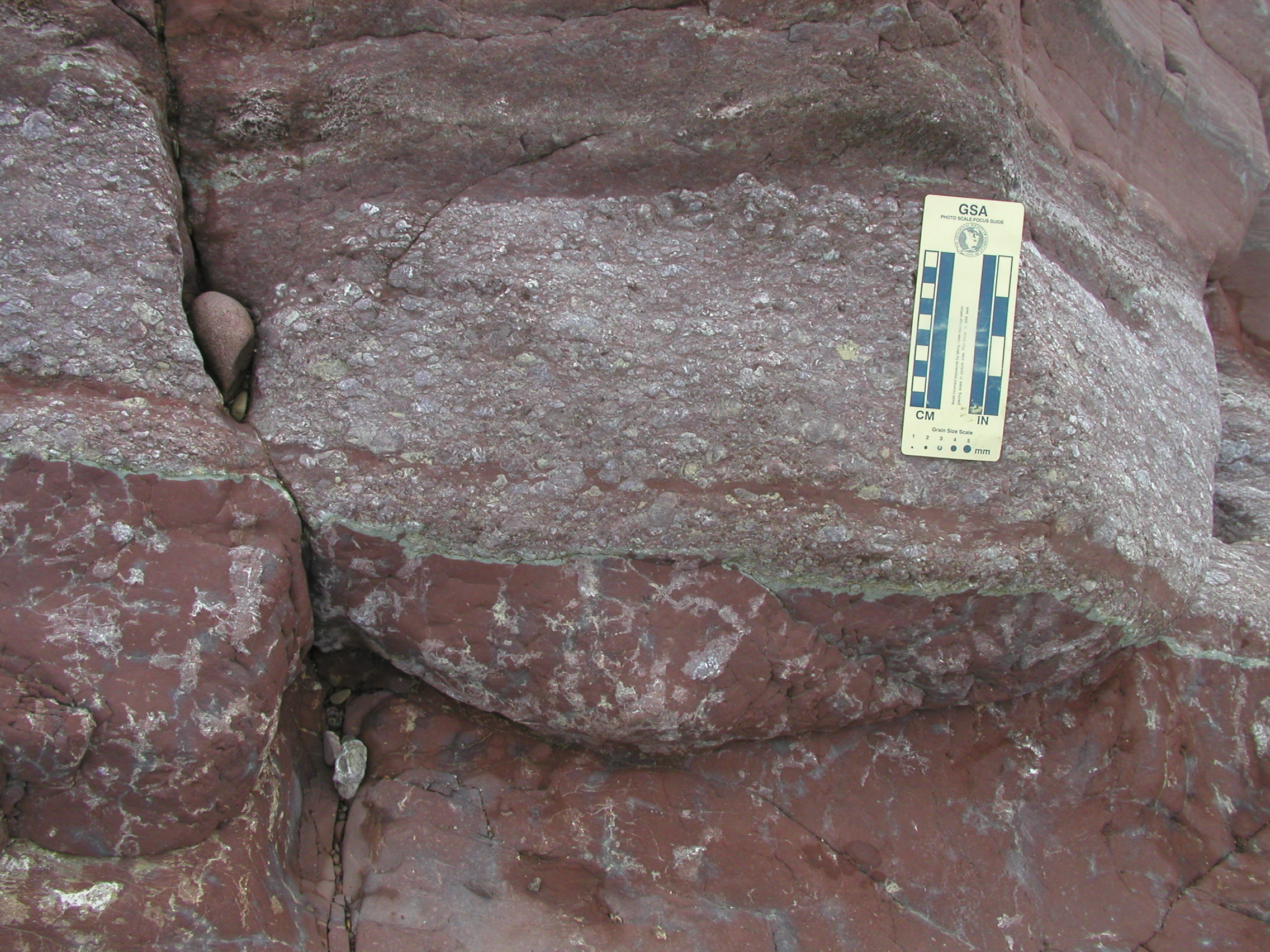
O
|
Photo
shows the top of Unit 4 and the basal contact of Unit 5. The white clasts
in unit 5 react strongly with dilute HCl. Think about their origin. |
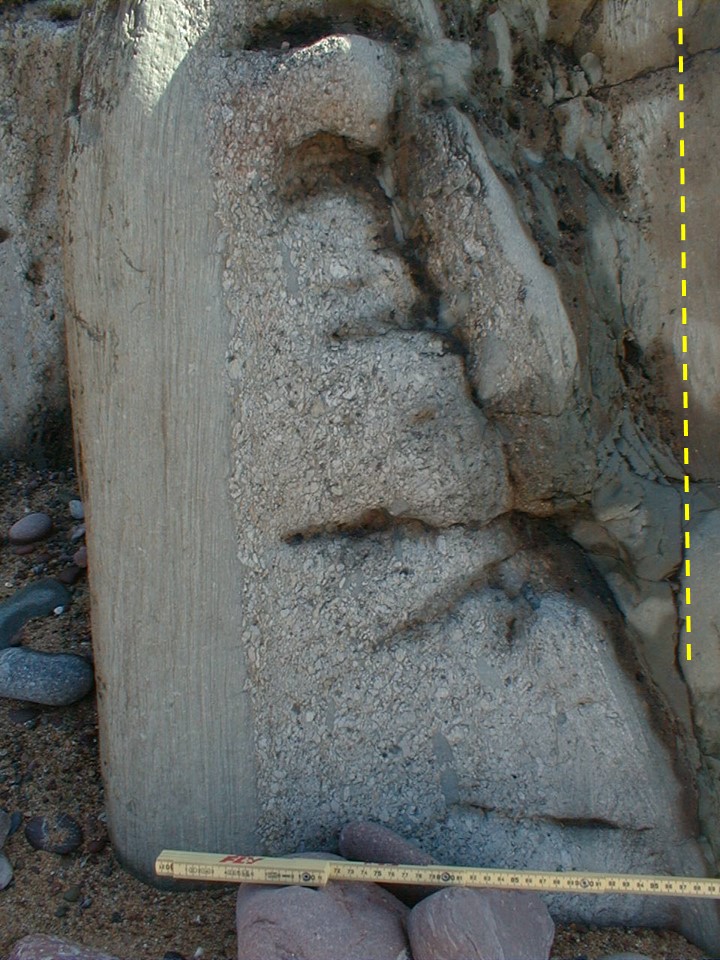 P
P |
Sub-vertical
dip; beds young to the right. Scale in cm. Photo shows the middle and upper
part of unit 5. The gradational contact with Unit 6 is indicated approximately
by the dashed line. |
| 6 |
gradational |
130 |
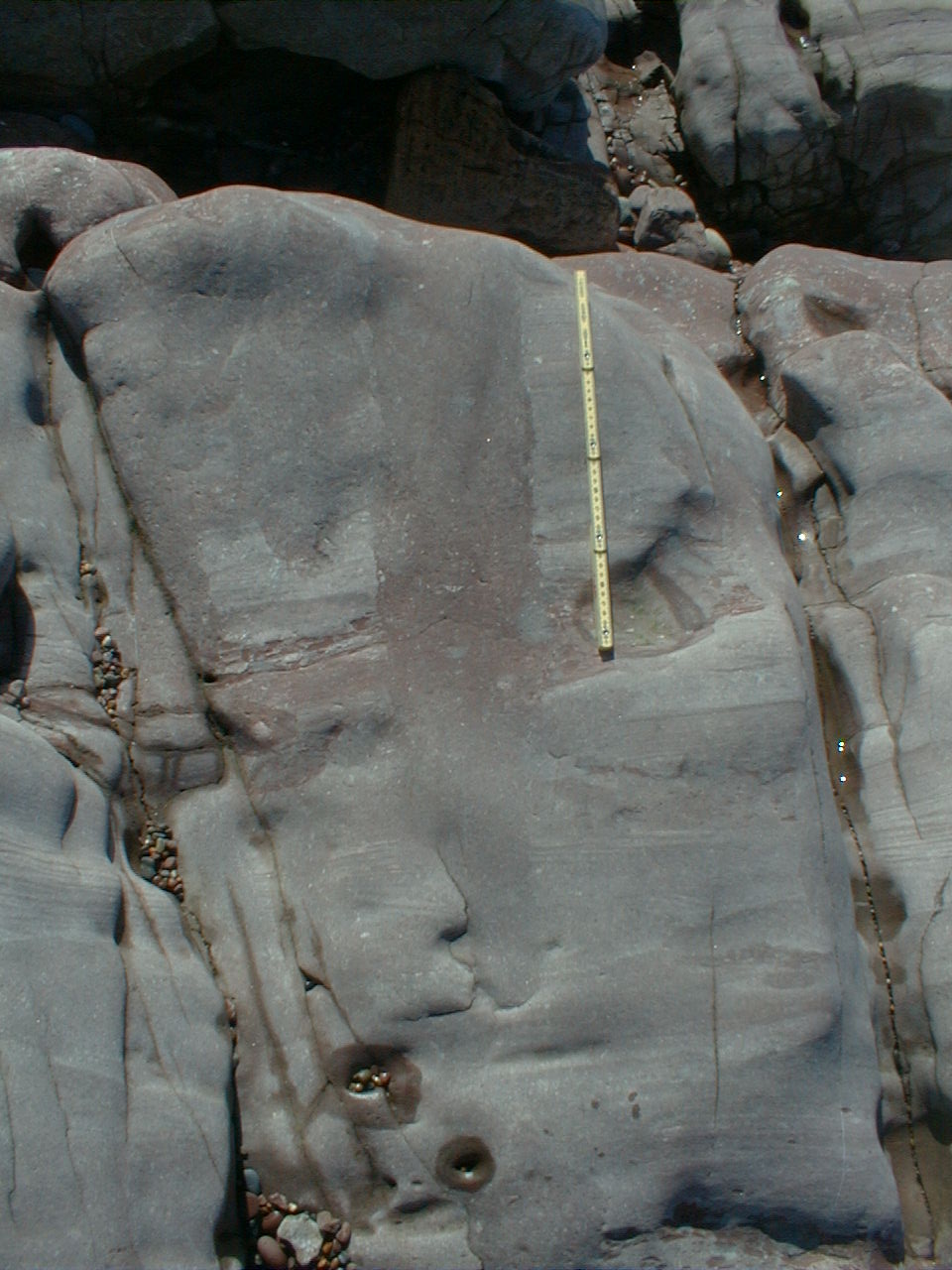 Q
Q
|
The lower part of
Unit 6. the contact with Unit 5 is just below the field of view. Scale
in cm. Bedding runs from left to right.
Describe the structures
cutting across the bedding. What is their 3D shape? How could they have
formed?
|
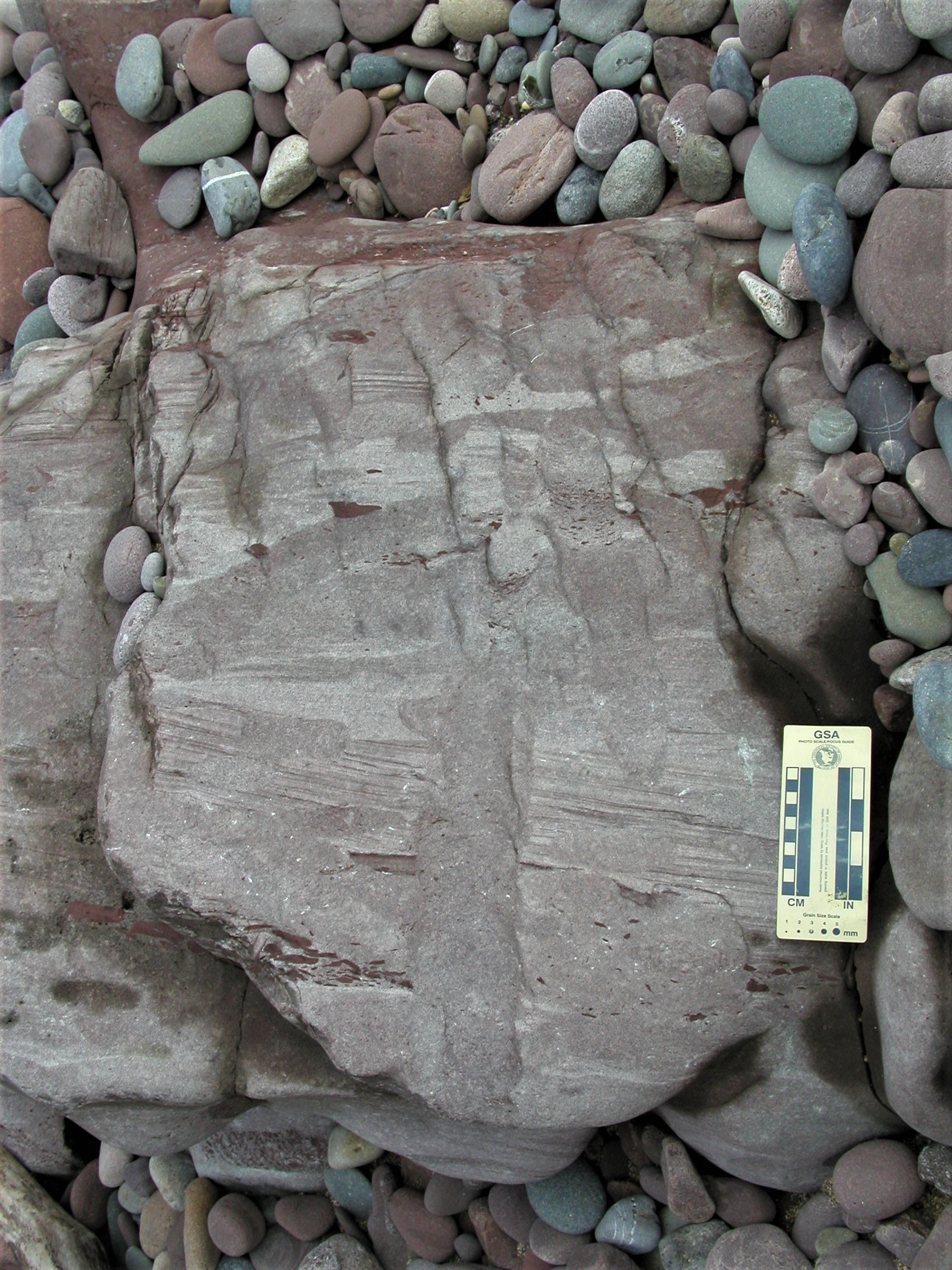 R
R |
The top of Unit 6.
Looking down on strata with sub-vertical dip. Similar structures to those
seen in photo Q.
The contact with
Unit 7 (red) is near the top of the photo - Unit 7 is mostly obscured
by beach pebbles.
Most of Unit 7 consists
of red siltstones and very fine sandstones, showing cleavage. Variable
amounts of irregular veins and nodules of calcium carbonate are present.
|
| 7 |
|
55 |
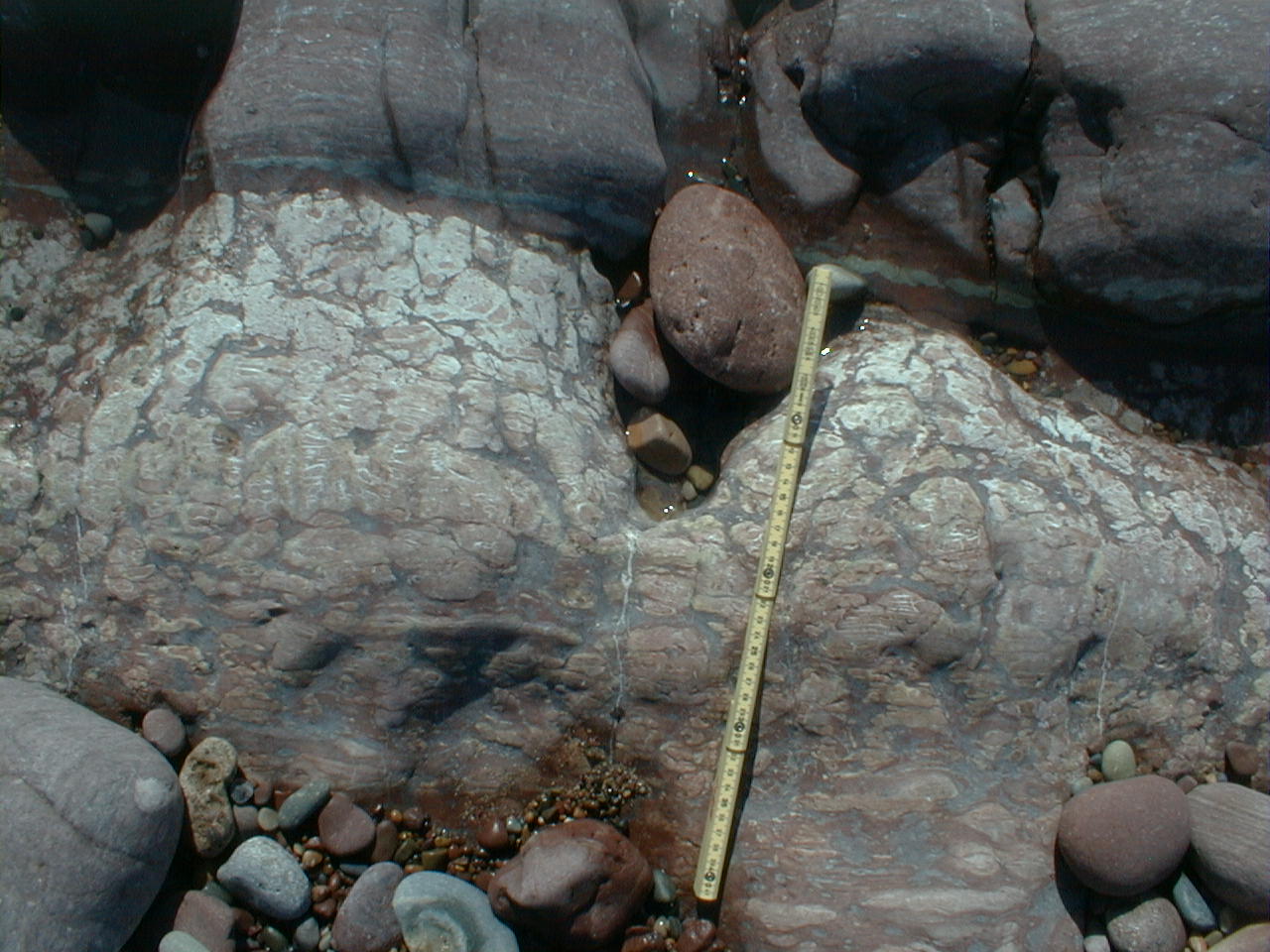
S |
Scale
in cm. The white material at the top of Unit 7 reacts strongly with acid.
The contact with Unit 8 is seen near the top of the photo, at the top end
of the tape. |
| 8 |
|
114 |
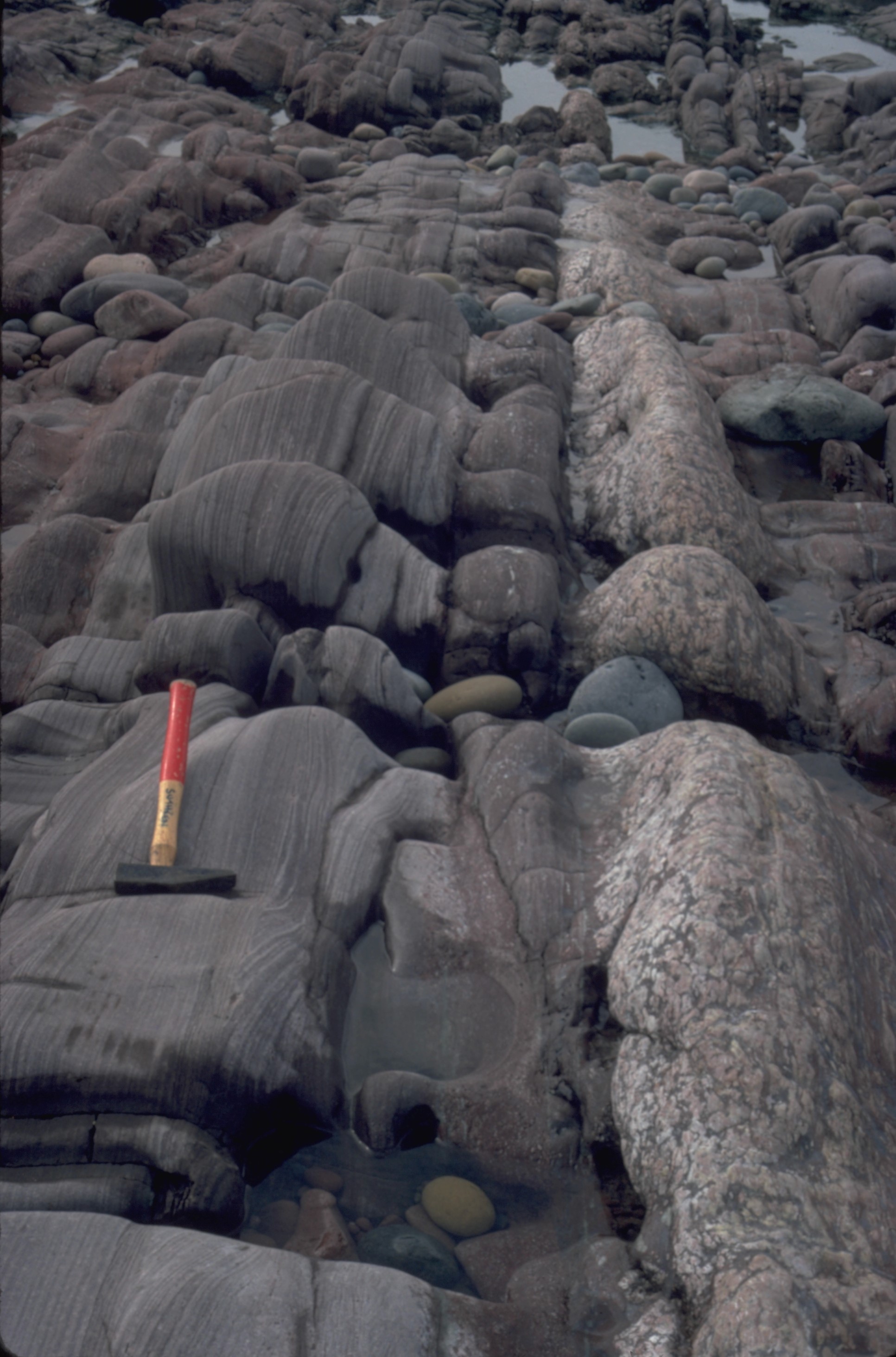 T
T
|
Another
view - this time along the strike - of the contact of Unit 7 (right, white)
and Unit 8 (left, red-brown). Hammer shaft is 30cm long. |
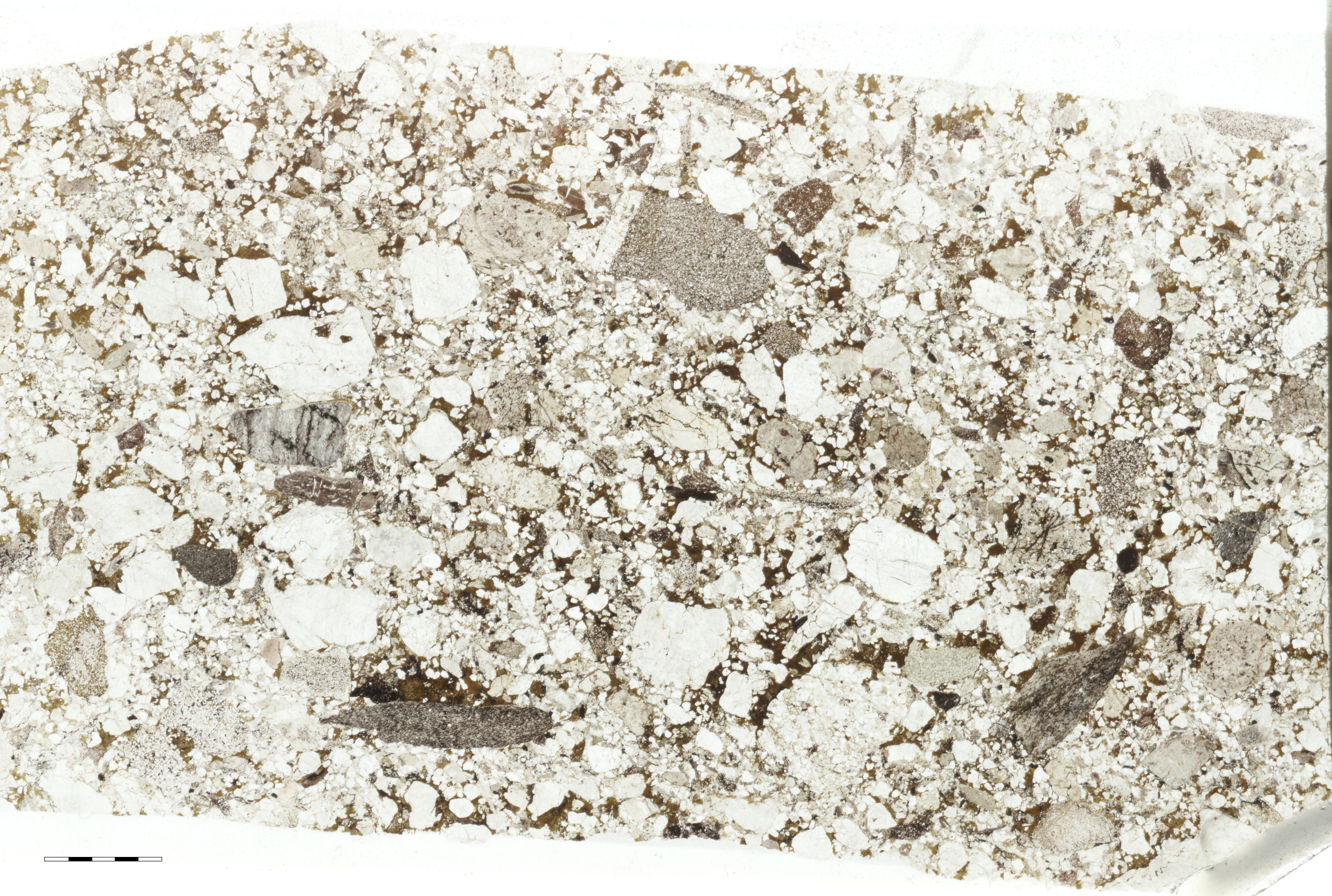
U |
Thin section
photograph of sandstone from Unit 8 in plane-polarized light. Scale bar
in mm. Describe the main textural and compositional features of the sandstone,
and give it a name using the Folk classification. |
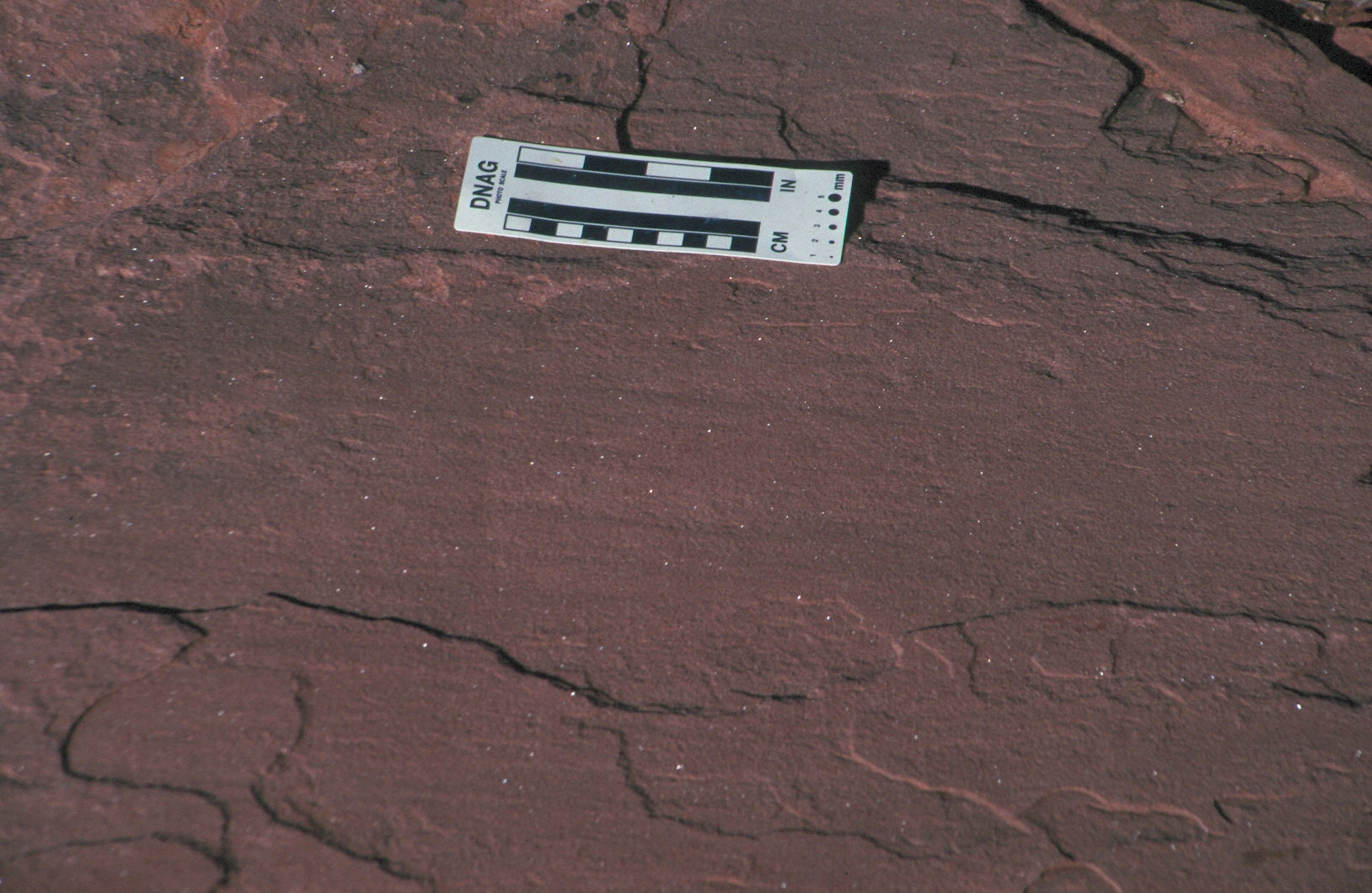
V |
About
60cm above the base of Unit 8 (left of the hammer handle in photo T), the
thin parallel beds of medium-coarse micaceous sandstone show this structure
on bedding planes. What is the structure, and what does it tell us about
flow conditions? |
| 9 |
gradational |
122 |
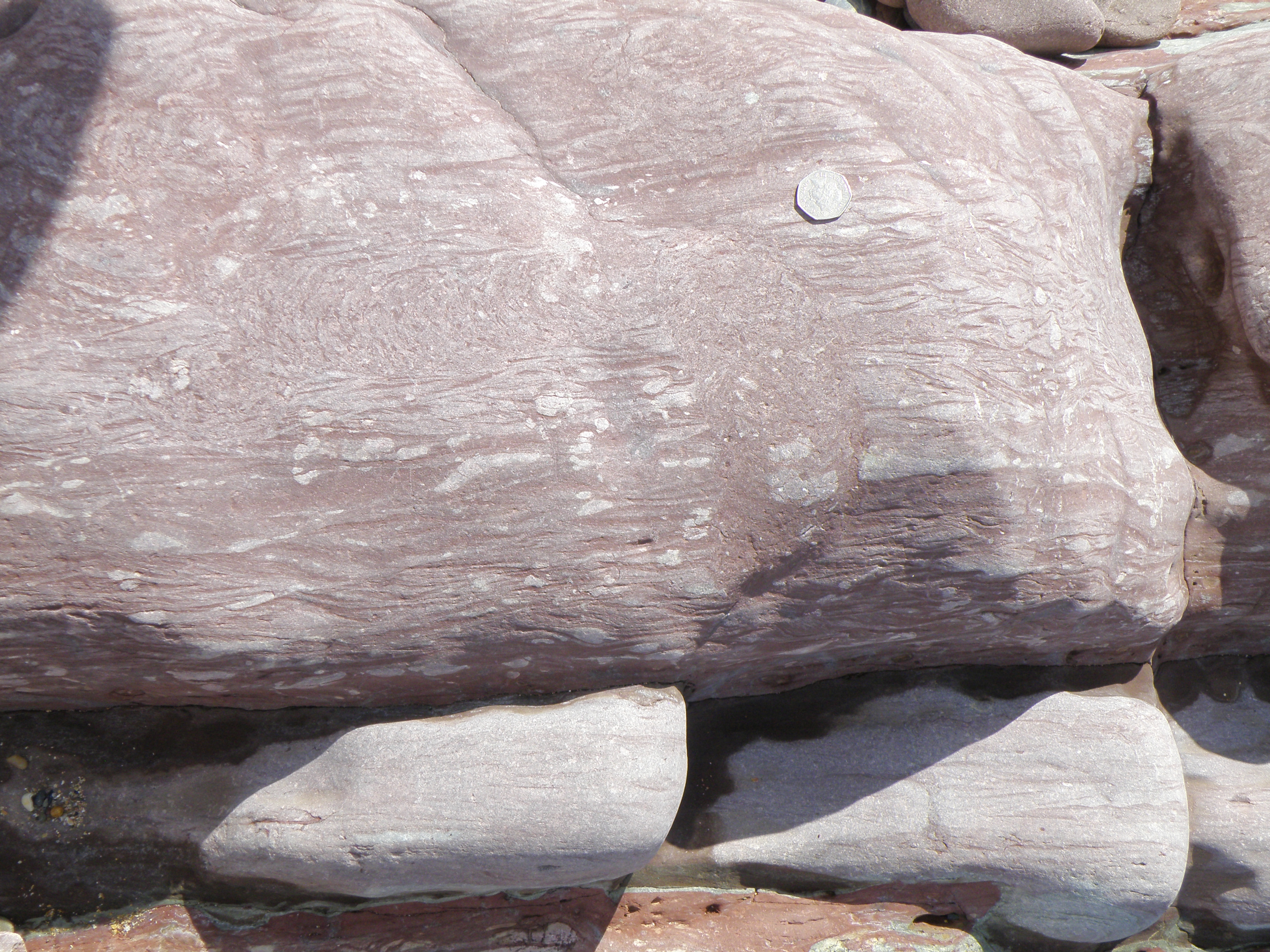
W |
Photo shows unit
9 from about 45 to 95 cm above its base. 50p coin for scale.
Describe and interpret
all the sedimentary structures present.
|
| 10 |
sharp,
planar |
145 |
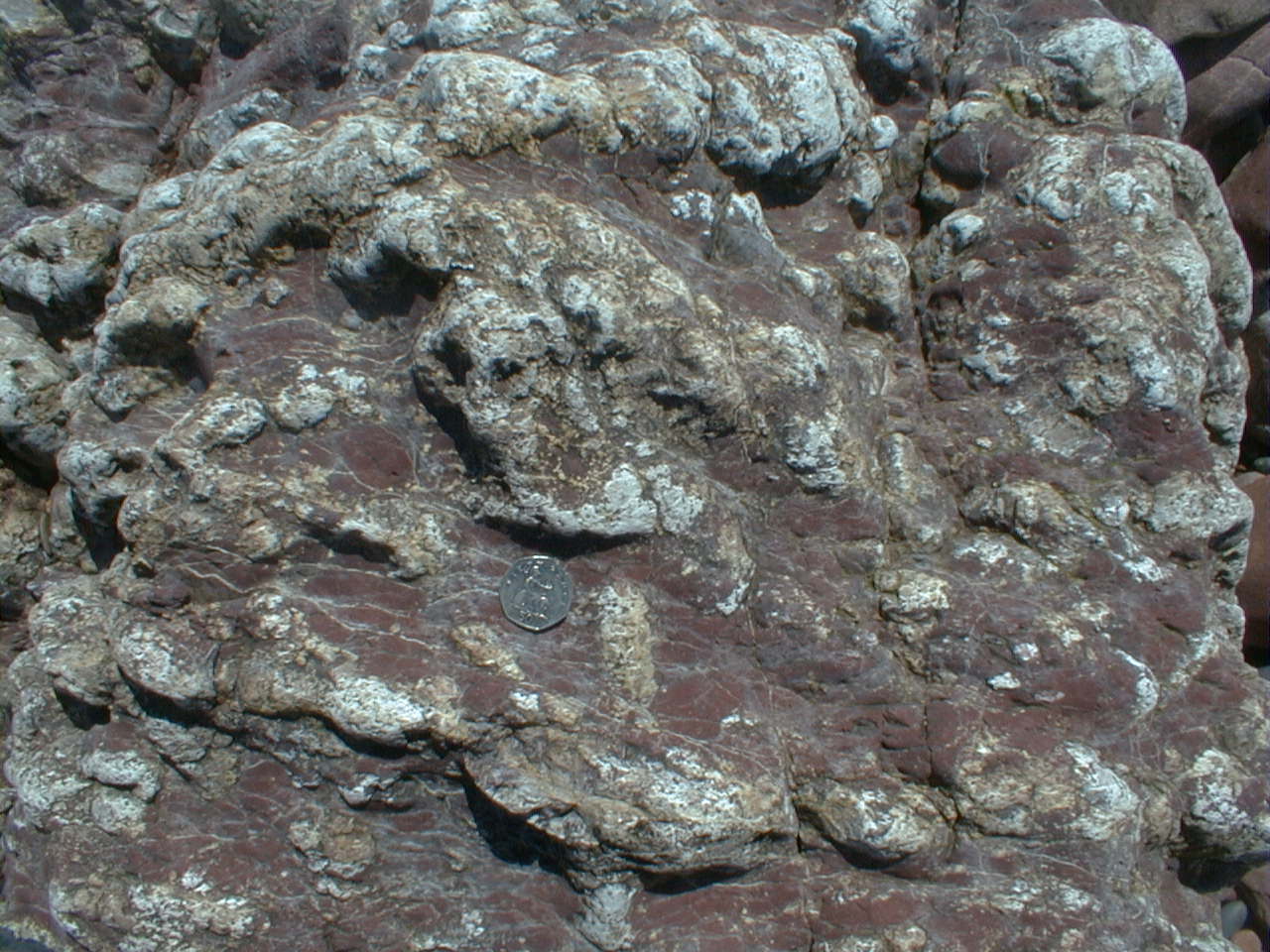
X |
Unit 10 consists
mostly of red-brown siltstone.
Photo taken towards
the top of Unit 10. 50p coin for scale.
|
| 11 |
sharp,
erosional |
30 (minimum);
top not seen |
|
Coarse
to very coarse green-grey sandstone, showing parallel bedding and planar
tabular cross bedding in 15cm thick sets.. |
Here are a few questions and hints
which may be useful in identifying and interpreting the outcrops on the log:
- Is there any systematic change
in sedimentary structures as you go up through each sandstone bed? What does
this tell us about flow conditions?
- Do you notice any cyclicity in
this section. If so, what is its significance?
- Are there any features suggesting
the presence of plants? What plants were around in the Early Devonian?
- Check out a
trace fossil called Beaconites. See the article by Morrissey and Braddy
(2004) in Geological Journal, v.39, pp 315-336.
Interpreting the field evidence
You have now acquired a variety of
different types of data on the sedimentary sequence shown in the log. This should
include lithologies, sedimentary structures and field relationships. Your task
now is to interpret the data.
- For each numbered unit or significant
surface on the log, write a brief interpretation of the processes and conditions
of formation in the righthand column of the log. Include in your interpretation
information such as environmental energy, flow regimes, salinity, oxygen levels,
depth etc. There must be evidence to support all of your interpretations.
- Suggest a depositional environment
for each unit.
- Write a short (250 word maximum)
interpretative account of changes in processes, conditions and environments
from the base to the top of the logged sequence in your virtual notebook.

The Ridgeway Conglomerate (upper
part of the Lower Old Red Sandstone)
We are now near the top of the Lower
Old Red Sandstone.Clast lithologies in the Ridgeway Conglomerate are often dominated
by vein quartz (white).
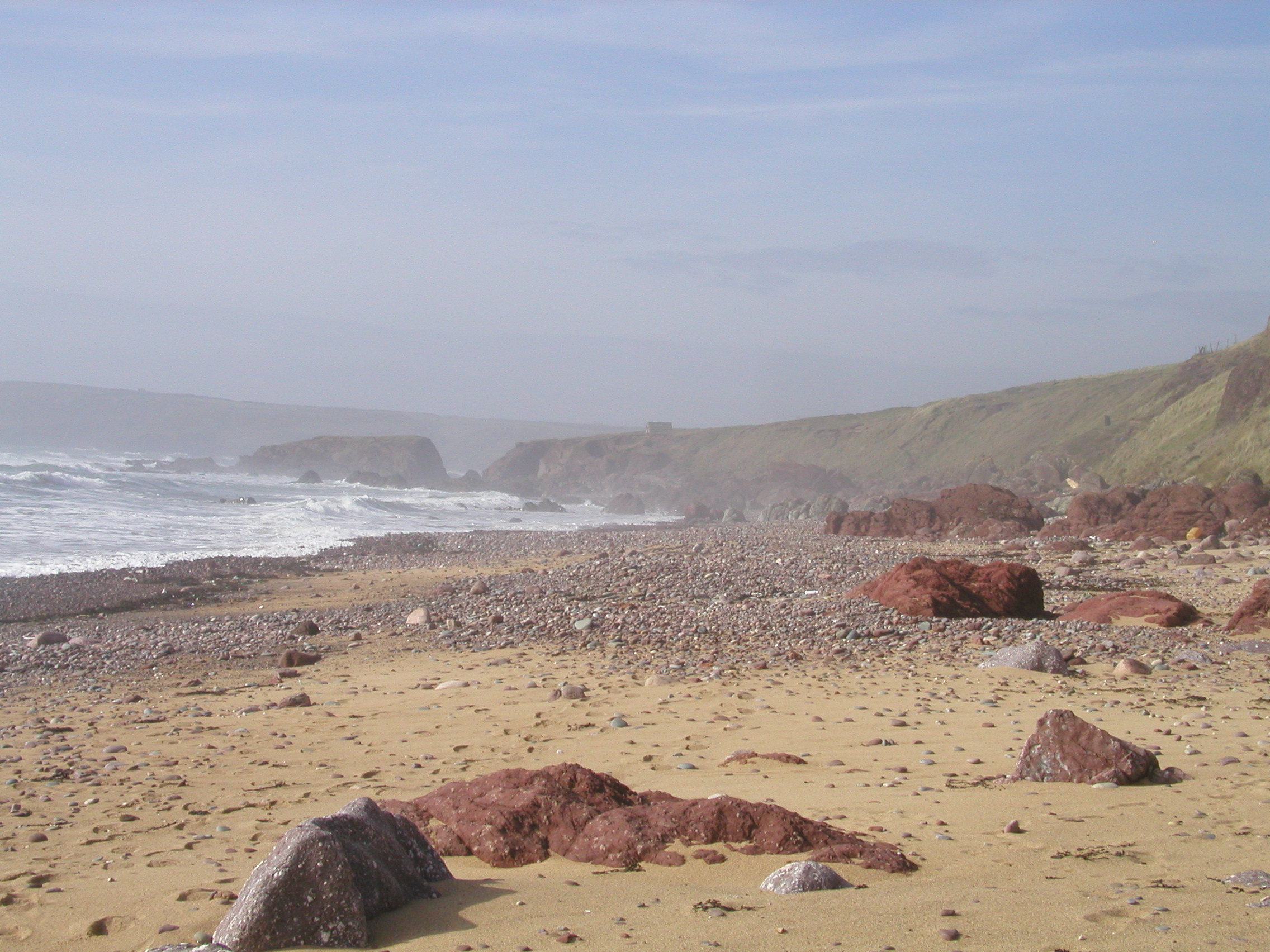
Y1. View south to Little Furzenip, with outcrops of Ridgeway Conglomerate
(conglomerate and underlying red siltstone with calcrete nodules) in the
foreground. |
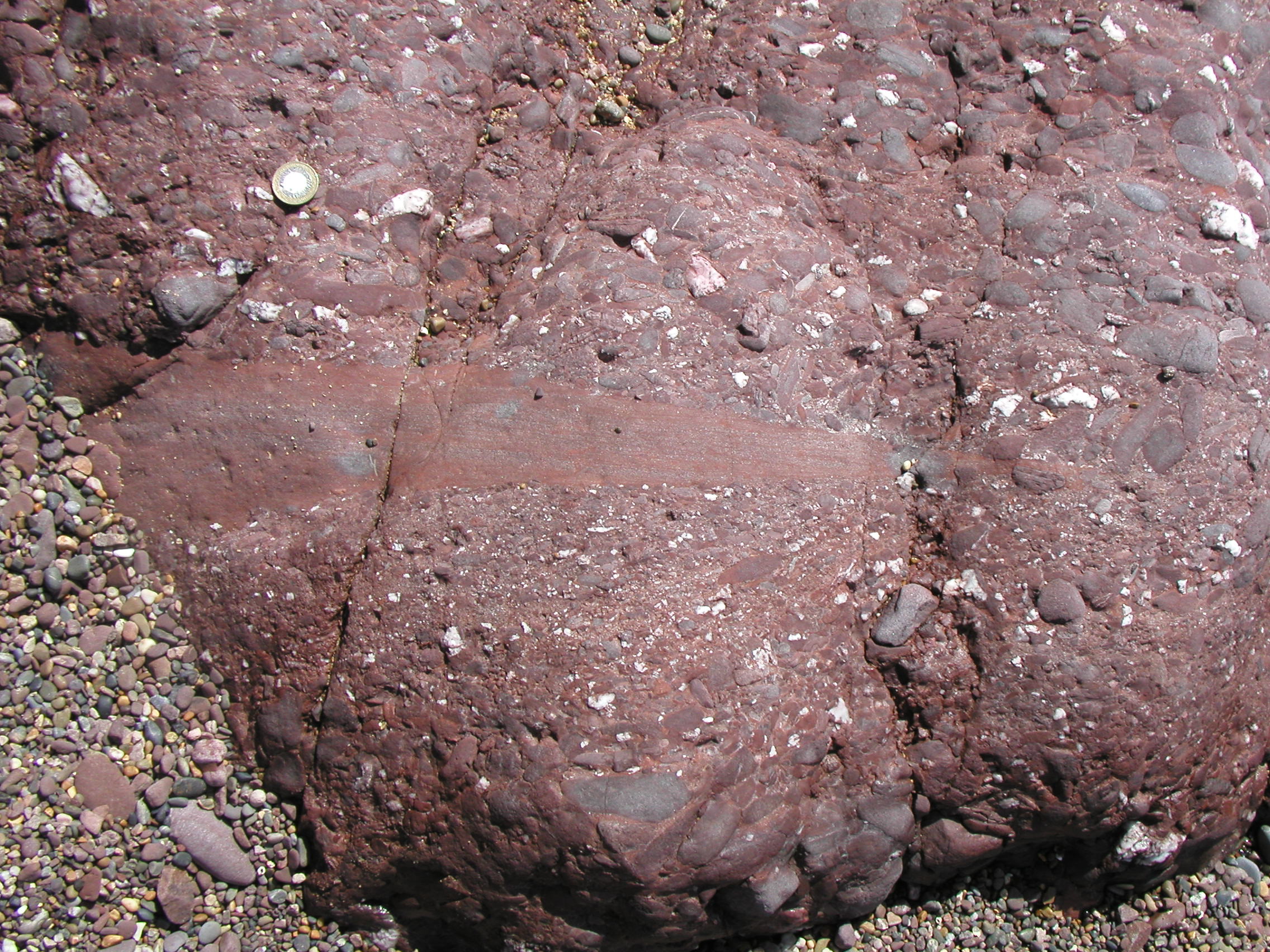
Y2. £1 coin for scale. Section through several beds of the Ridgeway
Conglomerate. |
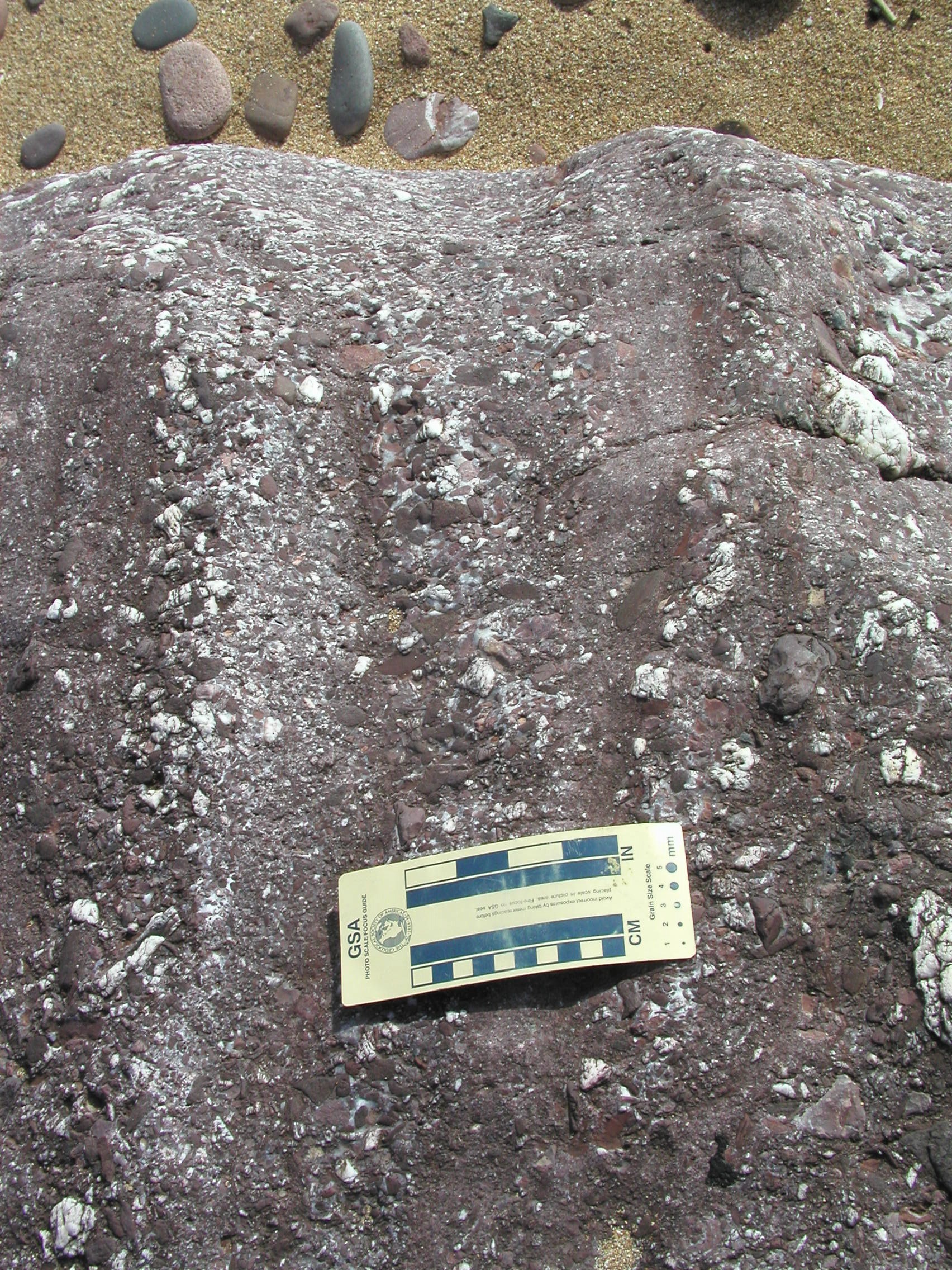
Y3. Dip is sub-vertical and section youngs to left (south).
|
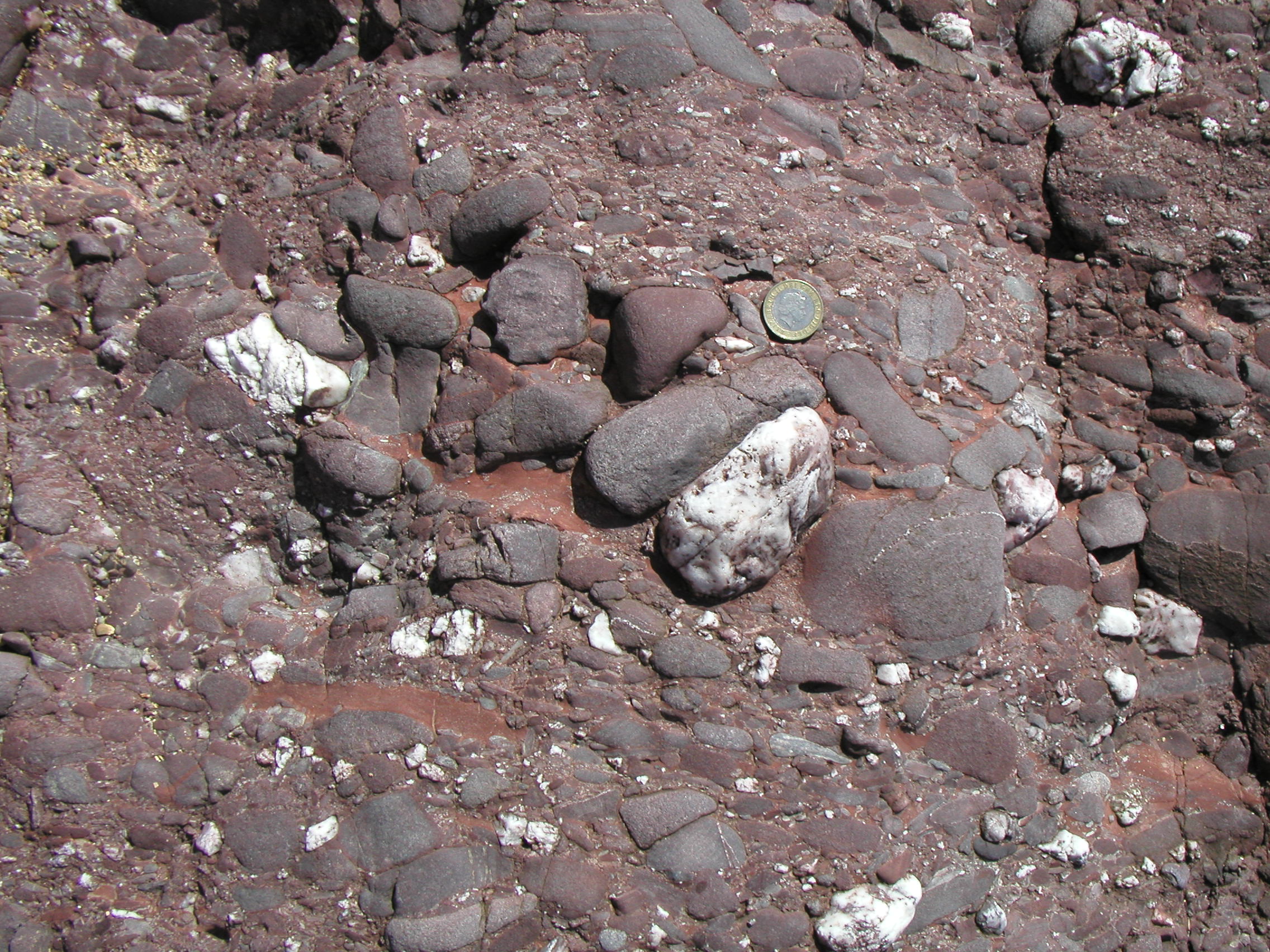
Y4. Section perpendicular to bedding.
What structure is
seen here? Try to identify clast lithologies.
|
In your virtual notebook:
- Describe the conglomerates using
the Hand Specimen Description Scheme in the Field Guide - it should
be easy to describe features such as grain size, grain shape and sorting.
- Identify and describe the sedimentary
features you can see in photos Y1 to Y4 - what do they tell us about processes
and conditions of deposition?
- Compare the conglomerates here
with those in the logged section in the Milford Haven Group - how do they
differ?

The Skrinkle Sandstones (Upper Old
Red Sandstone)
There is a major unconformity (not
obvious at this locality, because of the lack of angular discordance) at the
top of the Ridgeway Conglomerate. A large time gap is represented, following
the last phase of the Caledonian Orogeny. Thr Skrinkle Sandstones were deposited
on this erosion surface.
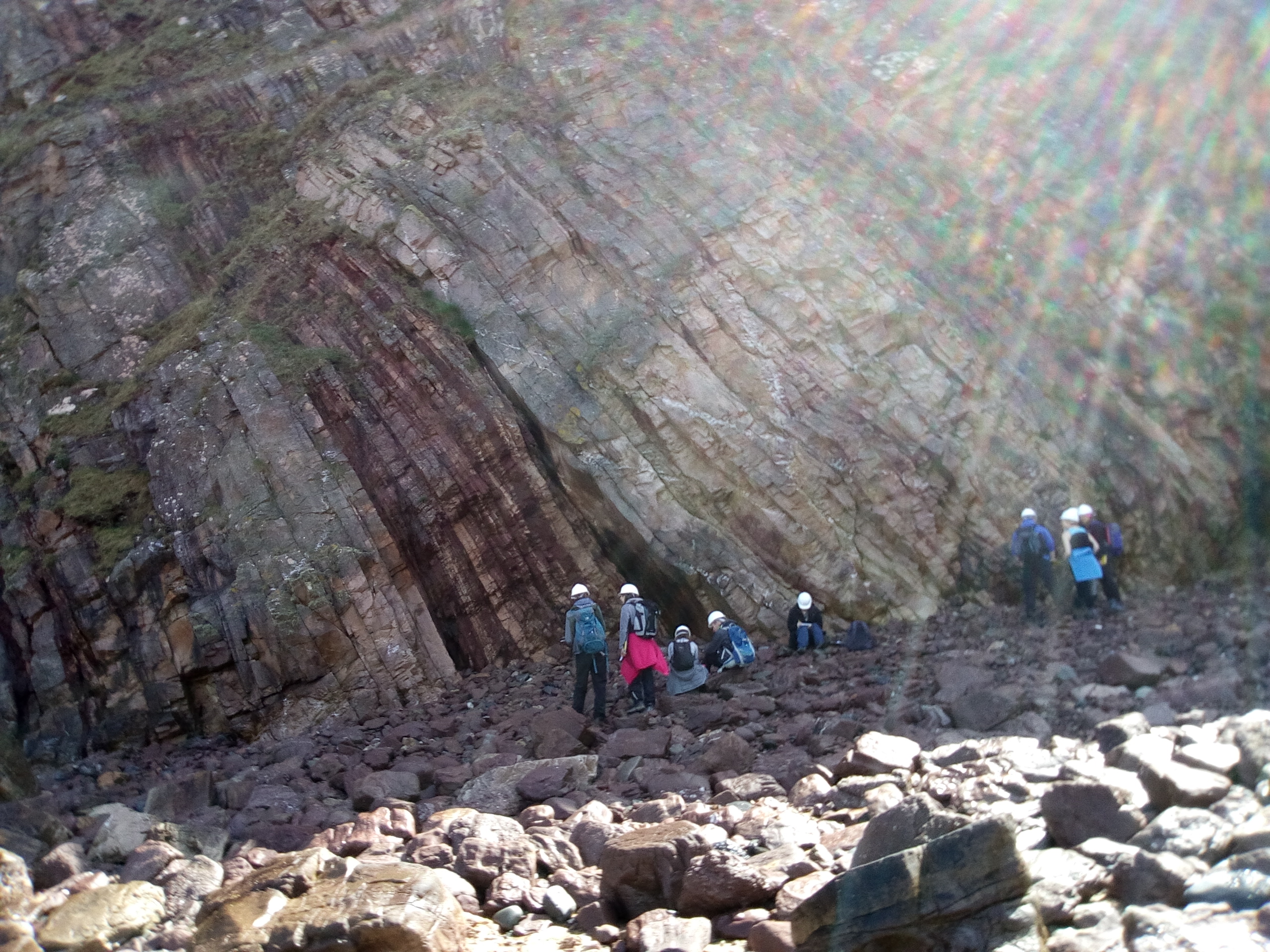
Z. These rocks are well
exposed in the cliff at the south end of the beach, near Great Furzenip. The
dips are still steep here, and the section youngs towards the south (right).
What can you see in this general
view of the section? We will study the Skrinkle Sandstones in more detail at
the next location - the two sections overlap.

Just for fun...
Let's grab lunch at Café
Môr - well worth a visit when you're down this way, and want to try
some really tasty local food.
 Film quiz: which well-known films had scenes shot at Freshwater West?
Film quiz: which well-known films had scenes shot at Freshwater West?

Next locality
Make sure you've completed all the
work for this locality. Now we can get back on the virtual coach and head off
to Skrinkle Haven, our next stop.

This page is maintained
by Roger Suthren. Last updated
19 May, 2021 2:26 PM
. All images © Roger Suthren unless otherwise stated. Images may be re-used
for non-commercial purposes.
![]()
![]()
![]()
![]()





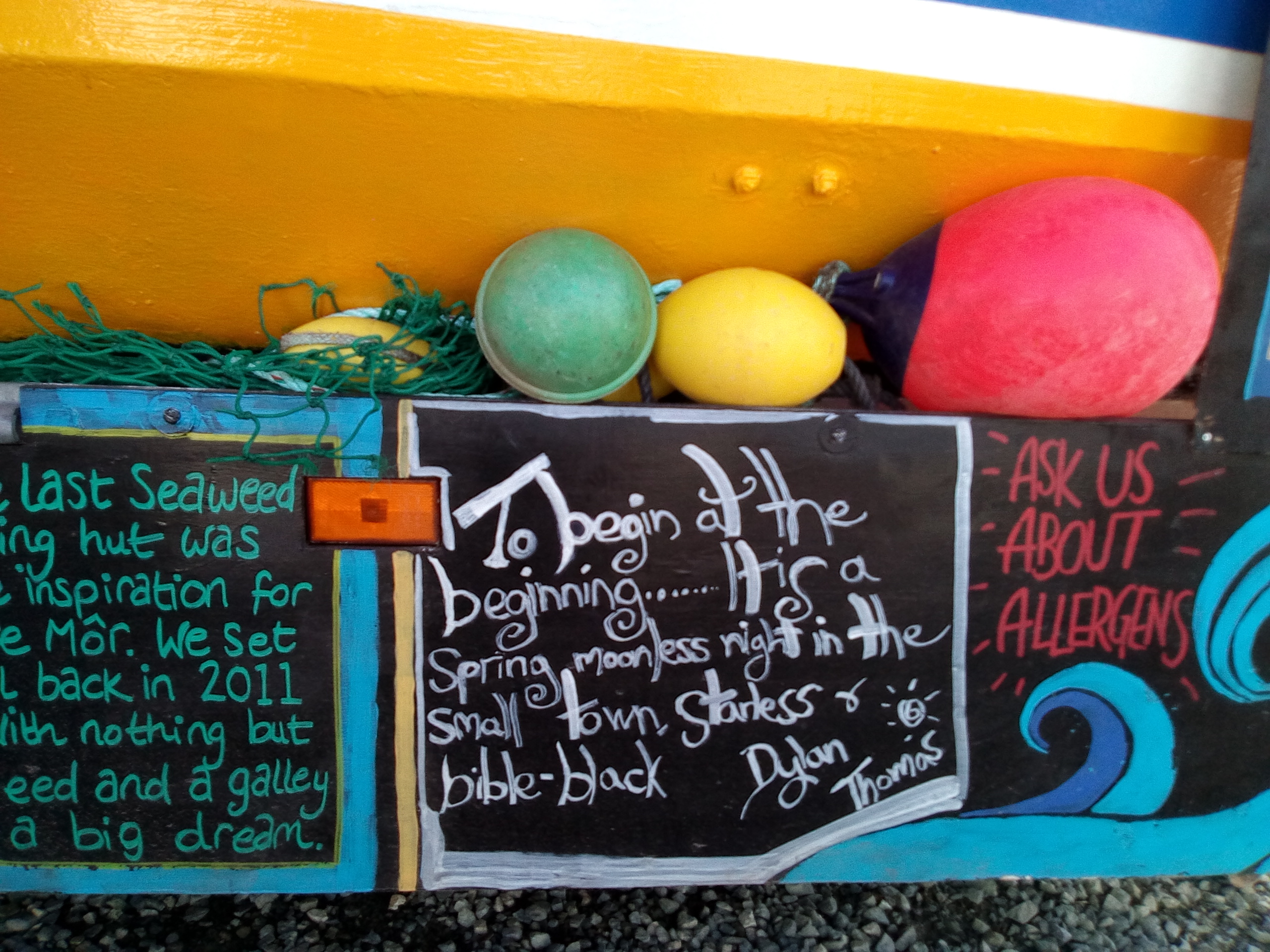

![]() Film quiz: which well-known films had scenes shot at Freshwater West?
Film quiz: which well-known films had scenes shot at Freshwater West?![]()
![]()